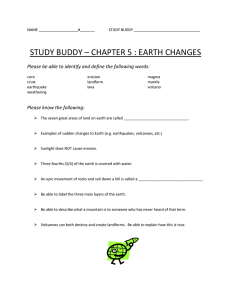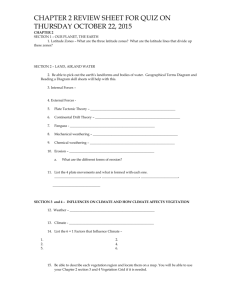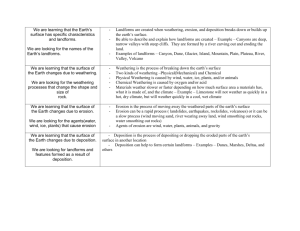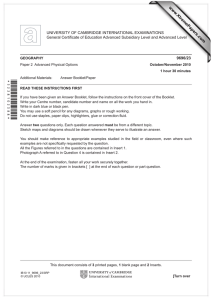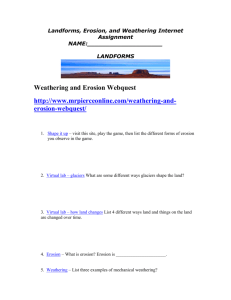9696 GEOGRAPHY MARK SCHEME for the October/November 2013 series
advertisement
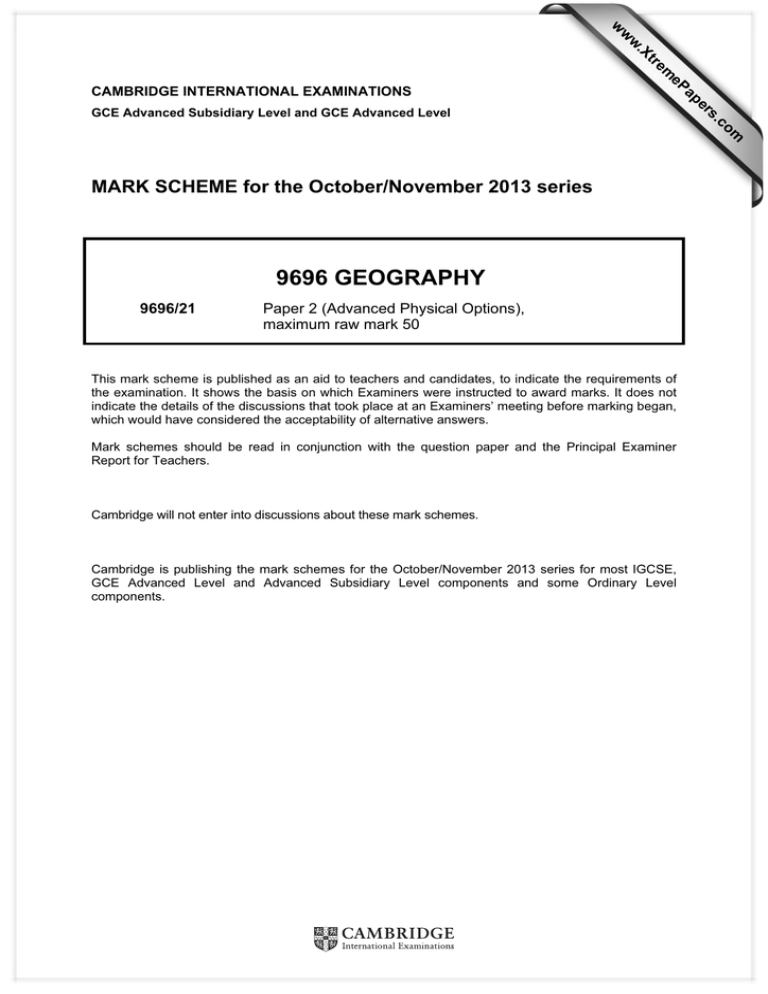
w w ap eP m e tr .X w CAMBRIDGE INTERNATIONAL EXAMINATIONS 9696 GEOGRAPHY 9696/21 Paper 2 (Advanced Physical Options), maximum raw mark 50 This mark scheme is published as an aid to teachers and candidates, to indicate the requirements of the examination. It shows the basis on which Examiners were instructed to award marks. It does not indicate the details of the discussions that took place at an Examiners’ meeting before marking began, which would have considered the acceptability of alternative answers. Mark schemes should be read in conjunction with the question paper and the Principal Examiner Report for Teachers. Cambridge will not enter into discussions about these mark schemes. Cambridge is publishing the mark schemes for the October/November 2013 series for most IGCSE, GCE Advanced Level and Advanced Subsidiary Level components and some Ordinary Level components. om .c MARK SCHEME for the October/November 2013 series s er GCE Advanced Subsidiary Level and GCE Advanced Level Page 2 Mark Scheme GCE AS/A LEVEL – October/November 2013 Syllabus 9696 Paper 21 Tropical environments 1 (a) Describe the characteristics of soils in tropical rainforest areas. Explain the factors that have affected the formation of these soils. [10] Soils in rainforest areas are developed on deep accumulations of regolith and thus have extended B and C horizons. This is composed of slightly modified parent material. The A horizon on top is relatively thin, low in nutrients and poorly sorted. Often referred to as latosol. The soils are acidic and with ppt greater than evaporation, the predominant movement is downward removing bases through leaching. They are frequently red in colour due to the accumulation of ferric compounds hence laterisation. Humus accumulations in the soil are low despite the abundance of vegetation as surface material is quickly broken down and recycled. The main factors are climatic (ppt and temperatures) parent material and nature of vegetation and nutrient cycling. (b) Fig.1 shows nutrient cycling in an area of tropical rainforest that has been cleared for shifting cultivation. Describe the nutrient cycling shown in Fig. 1 and explain the extent to which this differs from the nutrient cycle found in undisturbed tropical rainforest. [15] The nutrient cycle shown has stores that are roughly of equivalent size with relatively large flows between them. The smallest of the flows is that from the biomass to the litter, because a part of that has been taken out of the system as a crop. Losses from the litter and the soil are large through leaching. The differences between this and undisturbed rainforest is the large reduction in the biomass as a store. This has been depleted through clearance and its partial replacement through crops that do not act as a large nutrient store. The relative size of the litter and soil stores is likely to increase. Clearance of the canopy and the removal of crops exposes the soil and the litter to more rainfall and hence leaching and nutrient loss, which is one of the reasons for the decline in fertility of cleared areas over time. Level 3 Good understanding of the nature of Gersmehl diagrams and the nutrient flows shown. They will be able to relate the changes wrought by partial clearance and planting to the size of the stores and increasing loss of nutrients from the system due to leaching and cropping. [12–15] Level 2 Some interpretation of the nutrient flows but a more simplistic assessment of the impact of clearance which will largely be couched in terms of soil erosion and loss of fertility. [7–11] Level 1 Repetition of the diagram rather than interpretation. Clearance will be seen in terms of destruction of the system and consequent global effects. [0–6] © Cambridge International Examinations 2013 Page 3 2 Mark Scheme GCE AS/A LEVEL – October/November 2013 Syllabus 9696 Paper 21 (a) Using examples, describe and explain the characteristics of monsoon climates in the tropics. [10] Tropical monsoon climates are part of the tropical humid climates and are found mainly in India, S.E Asia and northern Australia. What makes them different is the marked seasonality of the climate, particularly precipitation. Temperatures are high throughout the year (over 25 °C in some cases) and precipitation levels are high (can be over 1000 mm). The word monsoon is derived from the term seasonal and is due to the effects of marked changes in pressure pattern. It is best illustrated by India and SE Asia. The development of a strong winter anticyclone over central Asia with very low temperatures giving way to low pressure associated with continental heating. Thus winds are outblowing from the continent in the northern winter giving dry conditions but are reversed in the summer where moist air is drawn into the low pressure areas. There are associated frontal systems together with orographic effects that can produce very intense rainfall. In coastal areas the monsoon rains can be unreliable. (b) Describe the landforms that have been developed in limestone in the tropics. To what extent have climate, vegetation and weathering contributed to the shape of these landforms? [15] Ideally candidates will concentrate on the more major landforms of tropical karst, such as tower karst and cockpit karst. Other features are of course appropriate, such as poljes, sink holes and pavements. These should be described (or a reasonable selection of them) and some ideas of scale and extent. Clearly carbonation is the main process and its operation should be described as the principal (although not necessarily sole) agent of weathering. Vegetation does play a part in the provision of humic acids and in the case of tower karst may contribute to the protection of the flatter upper surfaces. Climate, of course, is important in the provision of water for weathering and high temperatures enhance the rate of chemical weathering. The nature and structure of the rock, however, is very important in the shaping of many of these landforms which reflect varying levels of resistance and jointing in their shape. Level 3 Select and describe with some accuracy karst landforms that are most typical of tropical karst areas. Although the coverage may only be partial, there will be good understanding of the weathering processes involved and assessment of the roles of vegetation and climate. [12–15] Level 2 A more random selection of landforms but representing some affinity to the tropics. Some of the description vague as to scale and extent. Weathering processes understood, but rather generalised accounts of the influence of vegetation and climate. [7–11] Level 1 Landforms are more minor and generic (e.g. caverns, stalactites etc.). Little appreciation of the factors that produced them other than vague accounts of carbonation. [0–6] © Cambridge International Examinations 2013 Page 4 Mark Scheme GCE AS/A LEVEL – October/November 2013 Syllabus 9696 Paper 21 Coastal environments 3 (a) Describe the main sources of coastal sediment and explain how such sediment is produced within the coastal zone. [10] The sources of coastal sediment are river estuaries, cliff erosion, the removal of material from beaches and bars, and material excavated from the sea floor. Rivers deposit their sediment into the sea via deltas, estuaries and the like. Cliff erosion is produced by the main agents of marine erosion (hydraulic, wave quarrying, abrasion etc.) and by mass movements from undercutting and sub-aerial weathering. Material is removed from beaches and bars by destructive waves, whilst breaking waves and tidal movements can excavate material from the ocean floor. Some human activities might add small amounts to sediment supplies (e.g. beach replenishment, dredging etc.) (b) Photograph A shows some coastal landforms. Draw a sketch diagram to identify the landforms. Explain how the landforms were formed and to what extent they may be affected by human activities. [15] The photograph shows a spit with some dunes and a tidal area that could be described as salt marsh. The main feature is the spit which has clearly developed where the coast has changed direction as seen from the photograph (actually a river estuary). Long shore drift is thus bringing material from the direction of the top of the photograph and sediment (mainly sand) is deposited where the long shore current slackens. The protected area behind the spit allows the development of tidal marshes and the wind piles up sediments to form dunes. Human activities on the photo are represented by groynes to stabilise the beach and to prevent destruction of the spit by winter storms etc. It is possible that human activities could be destructive in terms of pollution or recreational use or drainage. NB If no diagram; limit to Level 2. Level 3 A useful sketch that shows the shape of the spit and identifies the main elements. Clear account of formation and some assessment of the possible human impacts. [12–15] Level 2 A sketch that is more textbook than actual or only partially identifies the features (e.g. dunes or tidal marshes missed out). Some understanding of the impact of LSD although limited in terms of the shape of the spit. Human activities in terms of groynes or over-use. [7–11] Level 1 Crude diagram showing merely an outline of a spit. Explanation only in terms of the zig-zag movement of beach drift. Human action seen as merely destructive. [0–6] © Cambridge International Examinations 2013 Page 5 4 Mark Scheme GCE AS/A LEVEL – October/November 2013 Syllabus 9696 Paper 21 (a) Explain the main characteristics of: (i) high energy waves, (ii) low energy waves, (iii) refracted waves. [10] Waves can be classified as to height, length, velocity and periodicity. They are generated by friction of the wind which is in itself the product of the distance over which it has blown. Thus when waves approach the shore the energy becomes more concentrated. In high energy wave areas, the fetch will be long and the winds high and frequent, giving rise to steep, breaking waves of greater frequency. In low energy cases, the waves will be longer, lower and of less frequency. This will be the result of smaller fetches and lower wind speeds. Refracted waves are those that adjust from waves at right angles to the wind to those parallel to the coast. This is the product of coastal shelving. Mark 3,3,3 plus 1. (b) Describe the main processes of marine erosion. Using examples, explain why the rate and effects of coastal erosion vary along a stretch of coastline. [15] The main processes are hydraulic erosion (wave pressure breaking down incoherent rocks), wave quarrying in joints where the air is compressed and then decompressed, corrasion (abrasion) where cobbles and pebbles are hurled against the cliff base. The reasons for varying rates of erosion are partly different wave activities; that is high and low energy wave environments but mainly due to geological variation. Thus less resistant, weakly consolidated rocks will erode faster than more resistant massively jointed rock such as granite. The structure of the rocks as well as type will also be of significance. Hence the slope of strata, the existence of bedding planes and jointing all have influences. Similarly the operation of sub-aerial processes and mass movements can make marine erosion more effective. Level 3 Clear, organised account of the processes of marine erosion and factors affecting wave strength. A realisation that geology is one of the main elements of the rates of erosion and this illustrated with reference to a particular coastal stretch. [12–15] Level 2 Competent, if at times confused accounts of marine erosion. Some sub-aerial and things such as solution may be included. Some may stray into resultant landforms. There will be some grasp of the role of geology although this may not extend much beyond hard and soft rocks, jointing etc. leading to headlands and bays. A collection of examples rather than a stretch of coast. [7–11] Level 1 Partial or unclear account of marine erosion with more accounts of geos, stacks and the like rather than the processes. Geology will not extend beyond hard and soft rocks and will be largely unexemplified. [0–6] © Cambridge International Examinations 2013 Page 6 Mark Scheme GCE AS/A LEVEL – October/November 2013 Syllabus 9696 Paper 21 Hazardous environments 5 (a) Explain how tectonic plate boundaries that are close to densely populated areas can be hazardous. [10] Plate boundaries are tectonically active areas on the earth’s surface that can give rise to volcanicity, earthquakes and associated hazards. Destructive margins produce crustal melting in subduction zones and this magma can find its way to the surface to produce volcanoes. Movement in the plates can produce stresses within faults that lead to earthquakes. These hazards can be pronounced in coastal locations (oceanic and continental plates) such as the circum Pacific ring of fire. Volcanism and earthquakes can lead to secondary hazards such as landslides and tsunamis. These boundaries are particularly hazardous when associated with densely developed urban areas such as in California or Japan. Their hazardous nature is exacerbated in LEDCs where prediction, prevention and amelioration are limited. (b) Fig. 2 shows some of the hazards associated with an eruption of the Nevado del Ruiz volcano in Colombia. Explain the nature of the hazards and assess the ways in which deaths from volcanic hazards might be prevented. [15] The most significant hazard produced by this eruption were lahars which resulted in the loss of over 20,000 lives. Candidates might not be aware of this, so it is acceptable for them to go through each hazard in turn. Lava flows although hot and toxic pose little threat as they were restricted to the summit area. They can however play a role in the melting of any snow and adding to lahar effects. Pyroclastic flows are high speed avalanches of hot ash rock fragments and gas. They are highly hazardous. Lahars are mud and debris flows along the flanks of volcanoes. They move very quickly and can overwhelm, as in this case, quite distant settlements. Ash clouds cover a wide area and can pose some threat to breathing. The most significant way of reducing loss of life is by evacuation of the population. The most effective way of doing this is through accurate prediction as once eruption has occurred little can be done. Methods of prediction need only be outlined. In this case warnings were ignored by the Colombian government with disastrous results. Level 3 Good descriptions of the volcanic materials with the hazards they pose. Reference made to the map. Intelligent appreciation of the need for prediction and indication of how it might be successfully executed. [12–15] Level 2 A less well organised account of volcanic materials and hazards with little reference to the map and an often underlying assumption that all are equally hazardous. Awareness of the importance of prediction but limited on how it might be achieved. [7–11] Level 1 A partial account of volcanic hazards with concentration on such things as lava. Prevention/ amelioration may be seen as lava dams and to some extent evacuation. [0–6] © Cambridge International Examinations 2013 Page 7 6 Mark Scheme GCE AS/A LEVEL – October/November 2013 Syllabus 9696 Paper 21 (a) Explain the causes and most common locations of tropical cyclones (hurricanes) and tornadoes. [10] Hurricanes are large scale depressions caused when cold air moves towards the equator to be met by warm air. The warm air is undercut and ascends forming a large scale circular system. The system is fuelled by high sea surface temperatures, most commonly in AugustOctober in the N. hemisphere in tropical locations. They do not occur within 5 degrees of the equator as they lack coriolis force to apply spin. They tend to move east to west and to be particularly devastating on low lying coasts in the Gulf of Mexico and Bangladesh. Tornadoes comprise a funnel shaped violently rotating vortex extending downwards from a cumulonimbus cloud in which it has formed. Again it forms at the junction of warm and cold air masses that develop very violent thunderstorms. The centre of the tornado has very low pressure. They occur most commonly in spring and early summer in the USA in ‘tornado alley’ (Texas, Oklahoma, Kansas and Missouri). (b) Describe the hazards that are produced by tropical cyclones (hurricanes) and tornadoes. To what extent is it possible to manage these hazards? [15] The hazards produced by hurricanes concern their very high wind speeds, intense rainfall, and storm surges. The high wind speeds can cause destruction over wide areas but generally claim few lives. Rainfall produces flooding and more importantly mudflows and landslides which can be very hazardous. The greatest loss of life is usually consequent upon storm surges on low lying coasts e.g. New Orleans, Bangladesh. Tornadoes are more restricted in their hazards, largely being limited to wind damage in the narrow path of the vortex. The ability to manage these hazards is limited. In both cases prediction is difficult as both have paths that are very difficult to estimate with any accuracy (particularly in the case of tornadoes). Some physical precautions can be taken such as the development of flood barriers in the case of storm surges, but these are often very expensive and not always effective. Evacuation often remains the best option although things like tornado shelters (cellars) can be built into some properties. Level 3 Good understanding of the meteorological causes of both hurricanes and tornadoes as well as an appreciation of how these causes influence when and why they occur. Knowledge of the hazards and a realistic assessment of the ability to manage them. [12–15] Level 2 Knowledge of the basic causes in terms of sea temperatures, spin (hurricanes) and thunderstorms (tornadoes). An awareness of where they occur but not well linked to causes. Spectacular wind destruction given a higher profile than storm surges and rather a list of ameliorative actions. [7–11] Level 1 Some knowledge of the properties but little as to the causes. Locations vague. Hazards largely seen as winds and management the provision of shelters. [0–6] © Cambridge International Examinations 2013 Page 8 Mark Scheme GCE AS/A LEVEL – October/November 2013 Syllabus 9696 Paper 21 Arid and semi-arid environments 7 Photograph B shows some vegetation found in a hot arid environment. (a) Describe the types of vegetation in Photograph B and explain how vegetation is adapted to survive in hot arid environments. [10] The photo shows a range of types of desert vegetation. In the foreground are grasses, cacti (3 kinds) in the middleground and in the background are thorny trees and bushes. Candidates are not expected to name the species (though credit if they do). They should be able to explain the adaptions of phreatophytes (e.g. grasses and perhaps bushes) with their long root systems. Cacti show water retention qualities as well as xerophytic adaptions of leaves and thorns etc. Better answers may also refer to the development of seeds that can withstand long periods of dormancy and the alkaline toxins found in some plants and stems. (b) Using examples, explain the problems facing sustainable management in either an arid or a semi-arid environment and evaluate attempted solutions to such problems. [15] The problems stem mainly from the climate in both environments and part (a) in some way is a lead into these. Essentially there is insufficient or unreliable rainfall and often extended droughts are followed on occasions by excessive rainfall. Resulting from the climate are sparse vegetation for grazing and soils lacking structure and low in nutrients. In the semi-arid case, better soils may have suffered desertification from a history of overgrazing, over cropping and deforestation for fuel, or be salt encrusted from inappropriate/widespread irrigation methods. In both environments the traditional ‘sustainable management’ has been nomadic pastoralism, but sustainable management today has to meet rising population pressures. Large resources of fossil water may exist at depth, as may mineral wealth, but environmental problems have acted against their exploitation. In many cases development is hindered by a lack of organised government controls or resources. Economic and social problems should not be overstated, but may have a place in the solutions part. The second demand to evaluate solutions should be firmly based on specific examples and not generalisations of improbable or unfeasible ones. Well presented and evaluated cases may come from MEDCs such as Israel and some Gulf States with highly sophisticated irrigation systems, desalinisation of sea water, etc. In much of Africa and other LEDC, solutions may depend on basic changes to practices such as paddocking of livestock, crop rotation, introduction of drip irrigation from rainwater harvesting or deeper wells to tap fossil water. Ecotourism may feature, including that related to game reserves, but sustainable management should always be considered in the evaluation. Level 3 Succinct but accurate coverage of problems and well presented and evaluated attempted solutions with good detail of at least one being a well developed example. [12–15] Level 2 Covers appropriate problems but with some lack of fine detail at the lower end of this level. Less specific solutions or fully realistic ones with limited evaluation. [7–11] Level 1 Limited and imprecise detailing of problems and little or no specific cases of solutions (e.g. develop tourism, dig wells, irrigate, introduce industries, etc.) [0-6] © Cambridge International Examinations 2013 Page 9 8 Mark Scheme GCE AS/A LEVEL – October/November 2013 Syllabus 9696 Paper 21 (a) Describe and explain the characteristics of climates in arid and semi-arid areas. [10] Aridity is an area receiving less than 250 mm rainfall a year. Their climates are dominated by high summer temperatures with diurnal variation greater than seasonal, episodic and rare precipitation, high energy wind environments with dust storms. They occur due to subtropical high pressure, continentality, rain shadow and cold ocean currents. Semi-arid areas have more rainfall which is seasonal but unreliable. Temperatures are high throughout the year. Rain is dependent upon the seasonal movement of the ITCZ such that uplift can bring about convectional rainfall. (b) Using examples, describe the processes of weathering and erosion that have produced landforms in hot arid areas. To what extent are landforms in hot arid areas the product of present day climatic conditions? [15] Weathering in hot arid conditions is largely limited to thermal fracture although the existence of dew and some moisture would allow for a limited amount of chemical weathering. Erosion is the result of wind action (limited in height and duration) and water erosion that stems from episodic rain storms and occurs as stream and sheet flows. Clearly neither activity is sufficient to carve out the great scale of desert landforms. The deep wadis, dissected mountain fronts extensive pediments with sharp knicks and the impressive scales of yardangs and zeugans. Most now accept current action as violent but episodic producing relatively little change. The landscapes are seen as relict and stemming from periods in the past (e.g. Pleistocene) when there was far more water and hence weathering and erosional activity. Level 3 Good understanding of weathering and erosional processes under present conditions with intelligent selection of landforms to illustrate the relict nature of desert landscapes. [12–15] Level 2 Thermal fracture dominates the weathering processes and wind erosion better described than sheet and stream floods. Past pluvial activity cited but with very limited evidence presented. [7–11] Level 1 Mostly concentrates on wind erosion and freeze thaw. Very little use made of desert landforms, past or present. [0–6] © Cambridge International Examinations 2013
